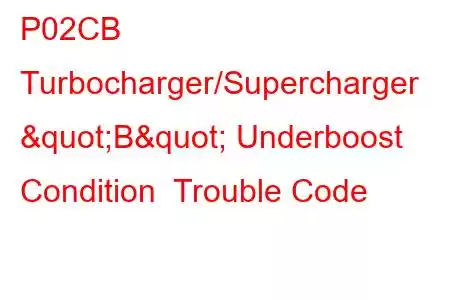P02CB Turbocharger/Supercharger B Underboost Condition
OBD-II Trouble Code Technical Description
Turbocharger/Supercharger B Underboost Condition
What does that mean?
This diagnostic trouble code (DTC) is a generic powertrain code, which means that it applies to OBD-II equipped vehicles that have a turbocharger or supercharger. Brands of vehicles affected may include but are not limited to Ford, GMC, Chevy, VW, Audi, Dodge, Hyundai, BMW, Mercedes-Benz, Ram, etc. Although generic, the specific repair steps may vary depending on make/model.
The P0299 DTC code refers to a condition where the PCM/ECM (powertrain/engine control module) has detected that the "B" turbocharger or supercharger is not providing a normal amount of boost.
Refer to a vehicle specific repair manual to determine which is the "B" turbocharger or supercharger in your particular application. That could be due to a variety of reasons, which we detail below. On a normally operating turbocharged or supercharged engine the air going into the engine is pressurized and that's part of what makes so much power for an engine of it's size. If this code is set, you will likely notice reduced power output.
In the case of Ford vehicles, this may apply: "The PCM checks for a minimum throttle intake pressure (TIP) PID reading during engine operation, which indicates an underboost condition. This DTC sets when the PCM detects that the actual throttle intake pressure is less than the desired throttle intake pressure by 4 psi or more for 5 seconds."
Symptoms
Symptoms of a P02CB DTC may include:
MIL (Malfunction indicator lamp) illumination Reduced power output from engine, possibly in a limp mode Unusual sounds from the engine/turboThere would likely be no other symptoms.
Potential Causes
Potential causes of a P02CB turbo underboost code include:
Intake (induction) air restriction or leak Failed or damaged turbocharger (sticking, binding, etc.) Faulty boost/charge pressure sensor Faulty wastegate bypass regulator valve (VW) Low fuel pressure condition (Isuzu) Sticking turbo nozzle control solenoid (Isuzu) Faulty injector control pressure (ICP) sensor (Ford) Low oil pressure (Ford) EGR system fault (Ford) Variable geometry turbocharger (VGT) actuator (Ford) VGT vanes sticking (Ford)Possible P02CB Solutions
First off, you'll want to repair any other DTC codes if present prior to diagnosing this code.
Start with a visual inspection. Inspect the intake air system for cracks, loose or disconnected hoses, restrictions, blockages, etc. Repair or replace as required.
If the air induction system tests OK, then you'll want to focus your diagnosis efforts on the charge pressure control, diverter valve (blowoff valve), sensors, regulators, etc. Really at this point you'll want to refer to a vehicle specific detailed repair manual for specific troubleshooting steps. There are some known issues on certain makes and engines so also check out our car repair forums here and search using your keywords. For example, if you search around, you'll find that a common fix for a P0299 in VWs is to replace or repair the diverter valve or wastegate solenoid. On the GM Duramax diesel, this code may mean the turbo housing resonator has failed. If you have a Ford, you'll want to next check the wastegate regulating valve solenoid for correct operation.
Read: 42


